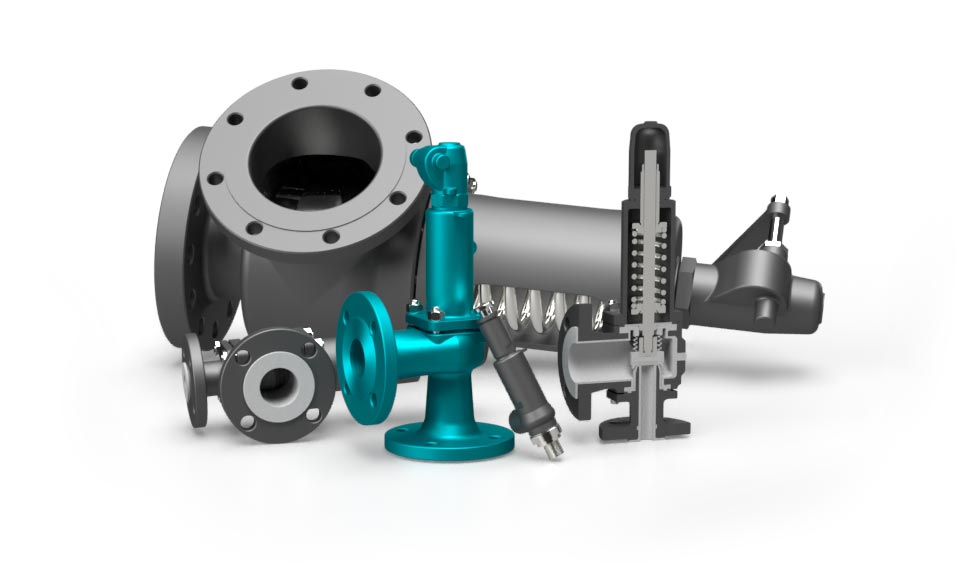k = isoentropic exponent
The importance of k for safety valve
edited by Alessandro Ruzza
by Rentato Pintabona and Panio Colacicco
The sizing of safety valves designed to discharge gases or vapours, according to lspesl Collection “E”, requires knowledge of the isoentropic exponent k at discharge conditions.
Careless application of the lspesl Collection “E” chapter “E.1”, concerning the sizing of safety valves, can lead to an overestimation of the discharge capacity of valves and rupture discs.
This article gives some guidelines to estimate the value of k for real gases and
highlights the mistake by considering k equal to the ratio of specific heats Cp/Cv
Isoentropic outflow through a nozzle
The formula [1] that is used in the collection “E”, as well as in other Italian [2] and foreign [3] standards, for the calculation of safety valves that must discharge gases or vapours, is that of the isoentropic outflow through a nozzle under critical jump conditions, which for an ideal gas is:
where the expansion coefficient C is given by:
| Fluid | P1 (bar) | T1 (°C) | q’ (kg/h) | q (kg/h) | (q’/q) x 100 |
|---|---|---|---|---|---|
| Methane | 12 | 50 | 1472 | 1466 | 100.4 |
| Methane | 23 | 200 | 2314 | 2267 | 102.1 |
| Propane | 12 | 100 | 2261 | 2181 | 103.7 |
| Hexane | 12 | 178 | 3099 | 2740 | 113.1 |
| Hexane | 23 | 220 | 6519 | 5111 | 127.5 |
| Heptane | 12 | 215 | 3232 | 2821 | 114.4 |
q’= flow rate calculated with k = Cp/Cv (20 °C, 1 atm)
q = flow rate calculated with k = (Cp/Cv) • (Z/Zp)
By introducing the experimental coefficient k of safety valve outflow, which globally considers the real outflow performance of the valve, a safety coefficient of 0.9 and the compressibility factor Z1 for the real fluid, we arrive at the formulation of the collection “E”:
The isoentropic exponent k can be expressed as:
For an ideal gas, for which P x V / R x T =1 , it is demonstrated that k is equal to the ratio Cp/Cv between the specific heats at constant pressure and volume.
For a real gas, k can be expressed (see Appendix B) by:
where Z is the compressibility factor defined by Z=P x V / R x T and Zp is the “derived compressibility factor”. When applying formula [3], according to collection “E”, the values of Cp/Cv, Z and Zp must be evaluated at discharge conditions P1 and T1.
The derived compressibility factor Zp is defined in formula [4] as:
The compressibility factor Z can be expressed as:
and similarly, can be expressed as:
where the values of Z^0, Z^1, Zp^0, Zp^1 are tabulated in Appendix A as a function of Pr and Tr.
In [4] and [5], Ω is Pitzer’s acentric factor defined by:
Where Pr^SAT is the reduced vapour pressure corresponding to a reduced temperature value Tr=T/Tc=0,7. Appendix A shows the Ω values of some fluids. Z e Zp can also be derived directly from an analytical equation of state.
A numerical example
Turning to a numerical example, suppose we need to calculate the discharge capacity of a safety valve under the following conditions:
| Fluid | n-Butano | |
| Physical state | superheated vapour | |
| Molecular mass | M | 58,119 |
| Set pressure | P | 19,78 bar |
| Overpressure | 10% | |
| Fluid temperature | T | 400 K |
| Efflux coefficient | 0,9 | |
| Orifice diameter | Do | 100 mm |
the discharge pressure is given by:
being for n-Butane: Tc=425,18 K and Pc=37,96 bar, we have:
and using the tables in Appendix A, we have:
Knowing the specific volume of the vapour at the discharge conditions (P1, T1) equal to 0,01634 m^3/kg (0,0009498 m^3/g-mole), we could also have calculated Z from the:
Given the ratio of the specific heats at constant pressure and volume, at discharge conditions (P1, T1), equal to 1,36, from formula [3] we have:
147060
Applying formula [1], which was solved for the calculation of the flow rate, we have a discharge flow rate value of 147.060 kg/h.
174848
If we had instead used the value of Cp/Cv at 1 atm and 20 °C, we would have had k = 1,19 and from formula [1] an discharge flow rate of 174.848 kg/h.
This would have led us to overestimate the discharge capacity of the safety valve by around 19%
WARNING:
The error that can be made by assigning the value Cp/Cv to k can be much higher than in this example.
OVER 20%
To give an idea, the following table shows the flow rates of an 18-mm orifice for other saturated hydrocarbons, calculated in the two cases. The calculations were performed with specially developed software.
| Fluid | P1 (bar) | T1 (°C) | q’ (kg/h) | q (kg/h) | (q’/q) x 100 |
|---|---|---|---|---|---|
| Methane | 12 | 50 | 1472 | 1466 | 100.4 |
| Methane | 23 | 200 | 2314 | 2267 | 102.1 |
| Propane | 12 | 100 | 2261 | 2181 | 103.7 |
| Hexane | 12 | 178 | 3099 | 2740 | 113.1 |
| Hexane | 23 | 220 | 6519 | 5111 | 127.5 |
| Heptane | 12 | 215 | 3232 | 2821 | 114.4 |
The software does not use formulae [4] [5] but, starting from the modified Redlich and Kwong equation of state, calculates the value of the isoentropic exponent using thermodynamic correlations.





![[2]](https://i0.wp.com/www.besa.it/wp-content/uploads/2022/06/Schermata-2022-06-30-alle-15.39.24.png?resize=250%2C81&ssl=1)
![[3]](https://i0.wp.com/www.besa.it/wp-content/uploads/2022/07/Schermata-2022-06-30-alle-15.39.46.png?resize=150%2C76&ssl=1)
![[3.1]](https://i0.wp.com/www.besa.it/wp-content/uploads/2022/07/Schermata-2022-06-30-alle-15.40.20.png?resize=200%2C76&ssl=1)







